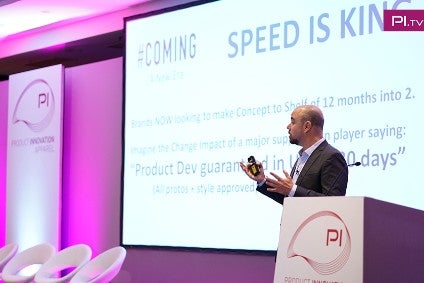
Faced with a paradigm shift in everything from the way raw materials are sourced, to how products are sold and the tools and technologies that make them, apparel brands and suppliers are still trying to work out the best way to navigate this rapidly-changing landscape. In the so-called ‘new era’, where speed is no longer an advantage but merely a necessity to remain competitive, there are nine key points that should be top of mind.
The key message from Asaf Landau, general manager at 3D design and prototyping software provider EFI Optitex, is that responding to market pressures – be it customer demands for ‘buy now/wear now’ or disruption from e-commerce as smaller order quantities and shorter lead times start to become the norm – is imperative.
“There is a significant change coming. We’re already seeing companies going out of business, multi-billion dollar companies that used to be brands we all knew, [that] no longer exist, or had to go into bankruptcy, or change who they are because they did not respond to some of the market pressures,” he says.
“There are other companies that are making a change as a consequence…and there are companies that have done it three and four years ago. There’s a definitive advantage to the ones that did it [then].”
A shift in power
In parallel with this macroeconomic shift has been a change in both the powerbase and role of sourcing companies, vendors and brands.
The powerbase has shifted away from the sourcing companies who connected brands with vendors, and “the brands now have much more power, control, and advantages when they go to the vendors directly. And the vendors, as well, gained a lot of power,” by servicing an increasing domestic market thanks to a growing middle class in Asia Pacific – meaning less dependency on brands based more historically in Europe and the UK.
How well do you really know your competitors?
Access the most comprehensive Company Profiles on the market, powered by GlobalData. Save hours of research. Gain competitive edge.

Thank you!
Your download email will arrive shortly
Not ready to buy yet? Download a free sample
We are confident about the unique quality of our Company Profiles. However, we want you to make the most beneficial decision for your business, so we offer a free sample that you can download by submitting the below form
By GlobalDataAnd as vendors became increasingly capable at serving their local markets, their role has evolved into original design manufacturers (ODMs), setting up private labels, and generally carving out a growing role in the value chain.
“Today there is really a relationship of mutual value-add,” Landau told delegates at last year’s PI Apparel (Product Innovation Apparel) event in Berlin. “Whether it’s a sourcing company or a vendor [you see] a desire to bring more value…and what that generally causes is a greater strategic relationship and it causes you to stop choosing just on price, as an example.”
Speed is king
And while price may not be the pain-point it once was, speed, too, is no longer just an advantage: it’s a requirement for survival.
Thanks to a push to go faster over the last few decades, production times have shortened from 90 days to 60 days. “But there’s not much more you can do in shortening production until concepts of local manufacturing, just-in-time, mass customisation and so forth are going to come into play.”
Instead, the real gains are coming from shortening the product development cycle where a “big, big portion of the time to go to market” is spent. “This is already possible today – and the foundation of it is 3D.”
He cites the example of Under Armour, which is now doing first-time approval in 80% of cases; and Marks & Spencer identifying 90% of its issues every time in digital before ever making a sample. This allows the retail group to make orders without samples, a feat deemed “unbelievable” by Landau.
But speed is not just about shortening the time from concept to shelf. “What exactly [speed] means in the business it not always clear,” Landau warns. “Speed is not an objective, speed is a methodology for achieving objectives and there are a number of examples.”
Efficiency: While just 40% of all styles that go into development are adopted as a world average, Landau says people are wasting their time, effort and focus on developing thousands of styles that will never come to fruition.
“All the extra time on the [styles] they didn’t adopt could have been spent on certainly going faster, on spending less resources, and being done earlier on making better product because they could be focused on the ones that they decided to adopt already.”
Earlier validation: “If I’ve got sales sample quality views of my design two weeks after it was drawn…then I can review it not only for adoption but review it with my buyers, with customers and find out what’s hot and what’s not in order to enable things that were not possible before in terms of customer feedback, market demand and intent.”
Better products: The adoption of technology really has differentiated between winners and losers. “If you are able to make as many changes as you want without the calendar being the pressure source…the response we hear from our customers in the first year is ‘wow we’re going a lot faster, things are more efficient,’ in the second year we hear ‘we’re just making better products now’.
“The ones that can go a little bit faster and make better products, the ones that focus on the 1,000 that they’re going to go to market rather than the 2,000 where half of them won’t, are the differentiators between who wins and who loses in the end.”
“3D is a big enabler”
Not surprisingly, Landau points to 3D design and prototyping tools as “a big enabler – it’s significant. We’re talking about digitising the core product of a US$1.3trn industry; every core business process that uses a physical sample.”
As he explains, 3D software allows brands and retailers to see, make and alter samples on-screen in hours as opposed to waiting months or weeks for the physical sample to be tweaked and adjusted.
The challenge, however, is to ensure that what has been designed digitally can also be created physically. “When we do product development, it’s physical products, when we do fit it’s physical product, when we sell it’s physical product, when we do photography, it’s physical.
“What we don’t want is to make something really beautiful and have the results be something that you could not then produce; that when you make a sample physically it won’t look the same; you’re not able to replicate what you see. It [may] look really great, which is wonderful for marketing, but if you’re not able to make a sample, you’ve spent a lot of time doing something that doesn’t play out fully.”
He adds: “The bottom line here is you’re able to do all the three or four or five or six iterations that you would like to do and instead of having the wait months and months and months between design and the results, you’re now able to see it one, two, three weeks later after all the iterations have been sale sample quality.”
And beyond that is the importance of scalability.
“We don’t only want ‘what you see is what you get’, we want to be able to communicate directly to production because when you do 3D on a smaller scale, it’s all fine but when you start to grow into hundreds or thousands of styles, you need that scalability to be part of the whole process.
“When you look at digital transformation, is not only about 3D, it’s about PLM, ERP systems. 3D is the enabler and the foundation for most it.”
But while technology is a tool, people are key.
“Technology does not make change, it is people that make change. And if you don’t organise yourself and structure the way that you do things and [how] you implement this, then you won’t be successful in it,” Laundau warns.
The winner’s guide
As the industry wakes up to the importance of embracing the digital transformation as an integral part of its business strategy and operations, Landau suggests nine ways to help navigate this rapidly-changing landscape.
1. Don’t wait for the industry to force you to change
“Press on courageously; start now,” urges Landau. “The timing and seriousness with which you adopt 3D will be one of your company’s most impactful business decisions. Take it seriously [and] drive it forward; look for the right partner; have a rough ride of it for one month [then] have a better ride three months later; a year later really feel like you’ve got a lot out it; but then, the year after that, [you’ll really notice] the impact on the business. So start early because this is something that you mature into.”
2. Motivate designers
“The intent of anybody hiring designers is to allow creative staff to be creative and to [help] you to bring the best product to market. We don’t believe in designers using our solution, we believe in designers enjoying our solution in other ways. We are making a solution for [them] that is not the same – it is a different product. It is the ability for somebody who is creative to be fully creative. And that’s a big, big difference.nIt’s a way to bring value without a burden to the individual that you want to keep creative.”
3. Motivate vendors
“He who offers the panacea of product development in 30 days is going to be the leader of the new era. He’s going to be the that you choose to work with more…but you’ll need to give them something back,” Landau notes. He suggests that once the supplier has gained the brand’s trust by delivering on speed and quality, to stop asking for the first prototypes and to go all the way through the development process in digital.
“At least the first one or two will go digital and then they see ‘OK I’m going to win more business, I’m going to less have effort, I’m going to make this effort for the next three to six months to prove this with measurable goals'”.
4. SMART proof of concept
Prove the technology can make one major improvement at a time and measure it using Specific Measurable Achievable Realistic Time-bound (SMART) proof of concepts. “What that means is you don’t try to prove everything at once, pick the one thing where you’re going to get value.” This may be measuring speed to approval, or the number of samples that need to be made physically, he says. “Take a look at your present state and where you can get to and measure it.”
5. Pilot with the right team
“If you have the wrong people doing something it won’t work. The people that should be doing it, should be computer savvy, curious, leaning into change. They often correlate to young, but really it is the level of energy and excitement and interest. “There are people that lean into change naturally and those that don’t. There are [people] who are computer savvy [but] it doesn’t mean they need to programme. There are some that like new things, to try them out and are not afraid to make mistakes; these are the people you want to choose.”
6. Right product
While both 2D and 3D are key in apparel, ultimately ‘What you see is what you get’ is the deal-breaker as it is critical for scalability, says Landau. “Therefore, having 2D and 3D and going all the way to production is really important.”
7. Right people
And while selecting the “right” people within your own company is important, Landau urges brands and retailers to also explore which are the best people to partner with at vendors.
8. Right process
He also pinpoints the importance of identifying the best practices for whatever goal your company is driving for.
9. Right partner
Finally, invest for today and for the long-term. “Technology is not something you should buy based on what it can do for you today, but where it’s going tomorrow and the next day and so forth.
“There is a change ahead, turn it into an opportunity and be the winner of that change.”







